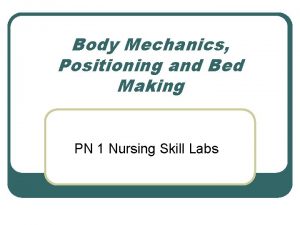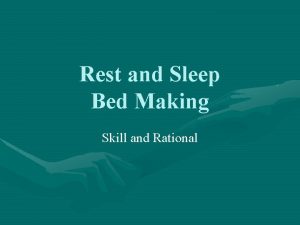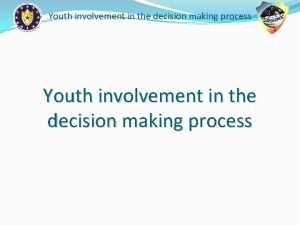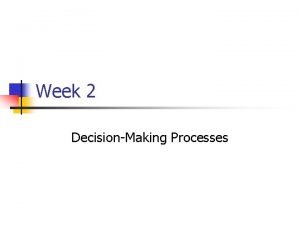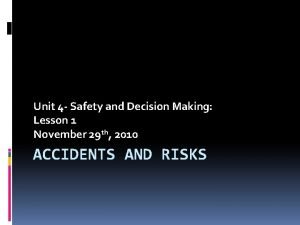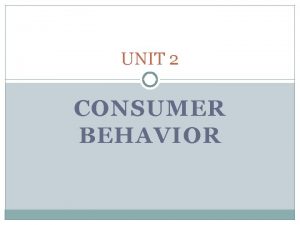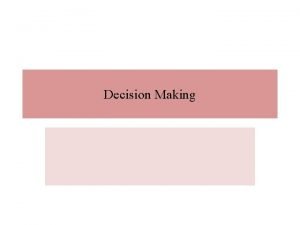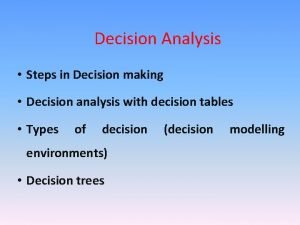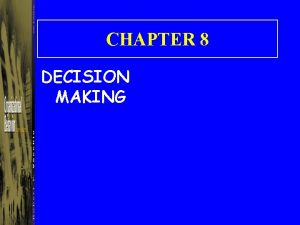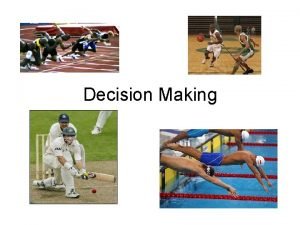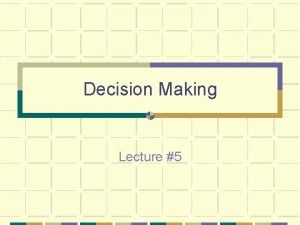Supported Decision Making in Action Creating Effective Coordinated


















- Slides: 18

Supported Decision. Making in Action: Creating Effective Coordinated Support Plans Jonathan Martinis Senior Director for Law and Policy The Burton Blatt Institute at Syracuse University Co-Project Director, National Resource Center for Supported Decision-Making

EVERYONE HAS THE S AME G OAL We ALL want “a foundation that will foster a lifetime of opportunity and happiness. ” “Many of the means to achieving those outcomes are the same: enrollment in postsecondary education, vocational training programs, experiencing work, and developing social networks that foster long-term meaningful relationships and opportunity for continued growth. ” - Gustin, 2015 National Resource Center for Supported Decision-Making EVERYONE has the Right to Make Choices 2

A C RITICAL D IFFERENCE For People With Disabilities: “Figuring out who the different service provider representatives are and what their roles are can take on a life of its own that often overwhelms families, mostly because the different service systems are not always clear on what their roles are or get into territorial role definitions that impact forward progress and planning. ” - Gustin, 2015 National Resource Center for Supported Decision-Making EVERYONE has the Right to Make Choices 3

T HE S OLUTION: A C ULTUREOF C OORDINATED S UPPORT “We must create cultural change by moving away from separation and silos. Instead, individuals, families, and providers must work together to empower people with disabilities to live independent, productive, and community-included lives. We call this a Culture of Coordinated Support. ” - Gustin & Martinis, 2016 4

I N A C ULTUREOF C OORDINATED S UPPORT People and Agencies: § Plan and coordinate their work “so that each knows what the others are doing and will do” § Ensure that the person’s various support plans describe how “each agency and provider will work with the others to help the person achieve his or her goals. ” Gustin & Martinis 2016 5

H OW? S UPPORTED D ECISION- M AKING State-wide, cross-program use of Supported Decision-Making is the key to creating a Culture of Coordinated Support. § Creates a “common tongue” for working with the person and coordinating plans and efforts § Ensures the person is at the center of the plans § Ensures that the agencies meet their obligations 6

C OORDINATION O PPORTUNITIES: C ROSS- S YSTEM P LANNING Education (schools, adult education services, training programs) Employment/Economic (VR, SSA, Representative Payees; Ticket to Work; WIOA) Health Care (Dept of Health, Doctors/health care providers) Legal/Advocacy (Lawyers, Courts, P&A, Advocacy Orgs like AARP, Arc, NAMI) Guardians (Private/Professional, GAL) Service Providers/Coordinators (Private Providers/Service Agencies) 7

B RINGING I T T OGETHER: A C OORDINATED S UPPORT P LAN The Coordinated Support Plan brings together and coordinates the person’s § IEP § IPE § ISP § Other Support Plans and Plans of Care So, plans and providers work together, more effectively and efficiently Gustin & Martinis, 2016 8

C OORDINATED S UPPORT S TRATEGY § Think. Listen Again § Identify Goals WHAT do I want? § Recognize Opportunities WHAT do I need to get there? § Spotlight on Strengths, Challenges, and Allies WHAT can I do? WHO can help me? WHAT’S in my way? § Coordinate Strengths and Allies HOW will we work together? § Address Challenges HOW will we get past the roadblocks? § Make it Happen WHEN do we start? HOW OFTEN will we review? 9

C REATING A C OORDINATED S UPPORT P LAN Review! Go through each area of your life. § Example: Financial, Medical, Social, Employment Brainstorm! Does you need some help in those areas? § If so, talk about what support could help, who could provide it, and how National Resource Center for Supported Decision-Making EVERYONE has the Right to Make Choices 10

W RITING C OORDINATED S UPPORT P LANS Write! plans addressing areas where you want support § WHAT is my goal? § WHAT do I need to get there? § WHAT is stopping me from getting there? § WHO can help me get there and HOW? § HOW will we all work together? § WHEN will we start and HOW OFTEN will we review? National Resource Center for Supported Decision-Making EVERYONE has the Right to Make Choices 11

I MPLEMENTING A C OORDINATED S UPPORT P LAN Make it a Part! The Coordinated Support Plan brings together and coordinates other plans: § IEP § IPE § ISA § Other Plans of Care So, include coordination in the plans or attach a separate plan to each, to guide implementation and ensure coordination National Resource Center for Supported Decision-Making EVERYONE has the Right to Make Choices 12

C OORDINATED S UPPORT P LANNINGIN A CTION Coordinated Support Plans for § Education WHAT do I want to learn to do? § Employment WHAT do I want to do for a living? § Financial HOW do I want to manage my money? § Health Care HOW do I want to manage my health? § Social WHAT do I want to do in my spare time? § ANYTHING ELSE National Resource Center for Supported Decision-Making EVERYONE has the Right to Make Choices 13

Y OUR T URN D ESIGN A C OORDINATED S UPPORT P LAN 16 Year Old with Down Syndrome § Wants to be a Veterinarian § Has limited independent living and employment skills § Has Medicaid National Resource Center for Supported Decision-Making EVERYONE has the Right to Make Choices 14

Y OUR T URN: D ESIGN A C OORDINATED S UPPORT P LAN 18 Year Old with Bi. Polar Disorder § Wants to leave school § Having behavioral issues, with a “bad crowd” § Has SSI § No employment goal, but wants to “make money” and “live on my own” National Resource Center for Supported Decision-Making EVERYONE has the Right to Make Choices 15

Y OUR T URN: C REATE A C OORDINATED S UPPORT P LAN 21 Year Old with Autism § Graduating in June § Living with aging parents § Interested in computers, has good skills but has interpersonal relationship issues § Has difficulty navigating public spaces/transportation National Resource Center for Supported Decision-Making EVERYONE has the Right to Make Choices 16

J OIN THE C ONVERSATION National Resource Center for Supported Decision-Making: Supported. Decision. Making. Org The Burton Blatt Institute at Syracuse University: BBI. Syr. Edu Jonathan Martinis, Senior Director for Law and Policy: JGMartin@Law. Syr. Edu National Resource Center for Supported Decision-Making EVERYONE has the Right to Make Choices 17

About this Project This project was supported, in part by grant number HHS-2014 -ACL-AIDD-DM-0084, from the U. S. Administration for Community Living, Department of Health and Human Services, Washington, D. C. 20201. Grantees undertaking projects under government sponsorship are encouraged to express freely their findings and conclusions. Points of view or opinions do not, therefore, necessarily represent official Administration for Community Living policy. National Resource Center for Supported Decision-Making EVERYONE has the Right to Make Choices 18
 No decision snap decision responsible decision
No decision snap decision responsible decision Investment decision financing decision dividend decision
Investment decision financing decision dividend decision Body mechanics in bed making
Body mechanics in bed making Effective body mechanics and bed making
Effective body mechanics and bed making Occupied vs unoccupied bed
Occupied vs unoccupied bed Decision tree and decision table
Decision tree and decision table Youth involvement
Youth involvement Ethical rules screen nasw code of ethics
Ethical rules screen nasw code of ethics Systematic decision making process
Systematic decision making process What doing our country
What doing our country Mamdm
Mamdm Using functions in models and decision making
Using functions in models and decision making Defining moments
Defining moments Unit 4 lesson 1 decision making
Unit 4 lesson 1 decision making How to improve marketing performance
How to improve marketing performance Types of decision making
Types of decision making Internal business management
Internal business management Contribution payoff table
Contribution payoff table Unstructured decision making
Unstructured decision making


